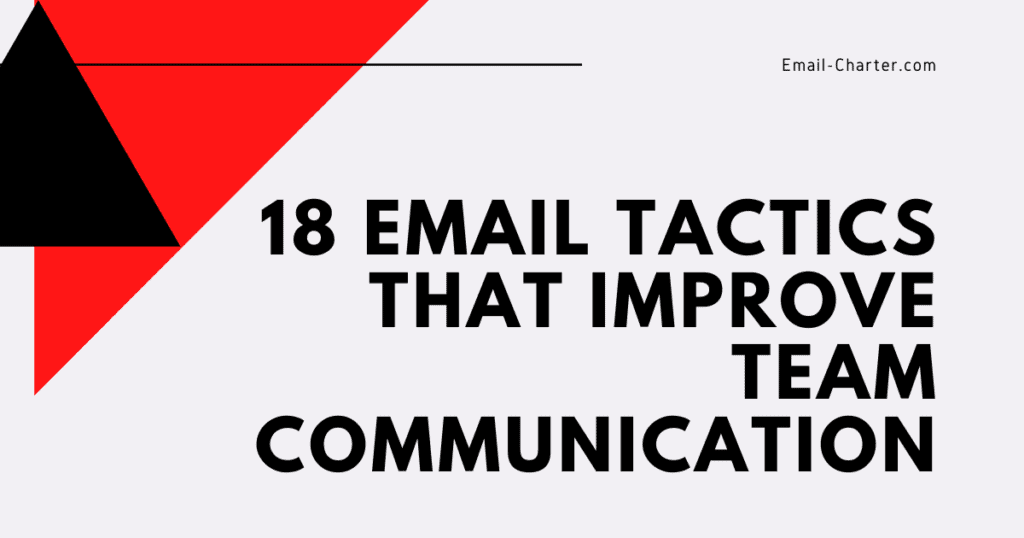
The following email charter includes 18 tips that will help you improve communication among your team.
Why an Email Charter?
There are two main problems with corporate email. The first is a quantity problem (we receive too many emails), and second, we have a quality problem (we receive too many bad emails).
This email charter was created to help solve both those problems within teams.
Email Charter Background
The idea of an email charter is not new. I first heard about it many years ago from the curator of TED, Chris Anderson. He wrote a blog post about the fact that everyone was drowning in email, and asked for help from his followers to create a charter.
He then bought the EmailCharter.org domain and listed a collection of 10 rules on the site.
I loved that charter, and I constantly referenced it in my courses and writings. However, for some reason, the website expired a few years ago, and the TED team never renewed it. So I kept getting pinged by a few followers about the fact that the link was broken.
After I wrote a book called “Don’t Reply All,” which included 18 email tactics that help improve team communication, I decided I would just include a summary of those tactics in an updated email charter.
So I bought the Email-Charter.com domain and uploaded those there. Feel free to check out the site and share it with anyone.
Note: The original email charter from TED included 10 rules, and mine includes 18. The rules & tactics are different in the sense that none of the titles are the same, and some rules in the original charter were about personal productivity (e.g. asking you to disconnect from email) whereas mine are mainly about team communication. However, there are obviously some common best practices between both, such as avoiding open-ended questions and using clear subject lines.
The Team Email Charter
Here are 18 tactics that will help you write better emails and improve communication among your team.
Tactic 1: Assign Tasks in an Email Using the “3Ws”
Every action should have a clear “Who,” “What,” and “When.”
Tactic 2: Write the Perfect Subject Line
Summarize your email, use prefix modifiers, and don’t change the subject line unless the subject changes.
Tactic 3: TL;DR – Write Emails That are Five Sentences or Less
Know what you really want first, and then get to that point at the top of your email.
Tactic 4: Break Long Emails into Two Parts
Label the two parts “Quick Summary” and “Details.”
Tactic 5: Make Your Emails Scannable
Use bullet points, subheadings, white space, highlights, and bold text.
Tactic 6: Show Instead of Tell by Attaching Screenshots
Use them to give someone instructions or to highlight slides in a deck.
Tactic 7: Spell Out Time Zones, Dates, and Acronyms
Be very specific and don’t make assumptions.
Tactic 8: Use “If…then…” Statements
For increasing accountability, setting expectations, and giving clarity on the next steps.
Tactic 9: Present Options Instead of Asking Open-Ended Questions
State “Do you think we should do A, B, or C?” instead of “What do you think about this?”
Tactic 10: Re-Read Your Email Once for a Content Check
Review it for incorrect responses, misquoted dates, or wrong facts.
Tactic 11: Save Drafts of Repetitive Emails
Use email templates for your weekly and monthly updates to improve communication.
Tactic 12: Write It Now, Send It Later Using Delay Delivery
Send emails when they’re most likely to be read.
Tactic 13: Don’t Reply All (Unless You Absolutely Have To)
Don’t use reply all when only the original sender needs to read your message.
Tactic 14: Reply to Questions Inline
List questions on separate lines and use different color fonts.
Tactic 15: Reply Immediately to Time-Sensitive Emails
Make your acknowledgements meaningful instead of just saying “Ok.”
Tactic 16: Read the Latest Email on a Thread Before Responding
Sort by subject line or use conversation threading.
Tactic 17: Write the Perfect Out-of-Office (OOO) Auto Reply
Include everything your recipient needs to know while you’re away.
Tactic 18: Share the Rules of Email Ahead of Time
Set up a short meeting with your team to agree on email best practices.
Found this Email Charter helpful?
If you found this helpful and would like to share the list of tactics with your team, visit Email-Charter.com (it’s a single page that is easier to read than this blog post).
And if you’d like to read more about each one of those tactics, check out my bestselling book about this topic called: “Don’t Reply All.”
